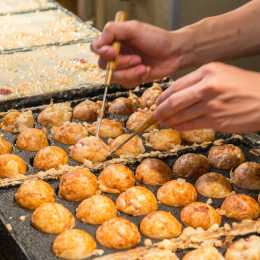What’s the Japanese Food you should eat? Everything. All of It. That’s what a friend said when I asked “What should I eat while I’m in Japan?” and we’ve been doing our best to live up to that… while keeping the budget in mind of course. This is a long old post (we ate a LOT of Japanese food,) but what there isn’t in this post is Kobe beef. We didn’t make it to Kobe and decided against the slices of Kobe beef on offer as street food in Osaka. Maybe next time?
THIS POST MAY CONTAIN COMPENSATED AND AFFILIATE LINKS MORE INFORMATION IN OUR DISCLAIMER
BEST WAY TO EXPLORE JAPANESE FOOD
Half Day Food & Drink Tour in Tokyo
This fabulous half day food and drink tour of Tokyo is incredible. Explore an area of the capital – your choice of Asakusa, Nakano, or Kichijoji. Find hidden izakayas, savor 8-10 local dishes and drinks.
Japanese Food
We’d started with Japanese food on the ferry over from Busan, South Korea – you know, the one where we had an entire 49 bed compartment to ourselves. We’d jumped on the first of our Japan Rail trains and headed straight for Nagasaki, where one of the specialties is Champon.
Champon
It’s noodles. And there’s a lot of inspiration from China in this dish. There’s pork in there, with vegetables and some seafood, and a soup with chicken and pork stock with ramen (egg) noodles. Designed to keep hungry students full, it certainly fills the belly. Nom Nom as they say. Eat Champon and other Nagasaki specialties – find out more here.

Heading further south and needing sustenance as we hiked around the wonderful Kumamoto Castle we found the local specialty of Mustard Filled Lotus Root, or Karashi-Renkon.
Karashi-Renkon
The crunchy lotus root has its holes stuffed with spicy mustard seeds and then the whole thing is covered with a batter and fried. You generally eat it cold. We bought a small piece from Kumamoto castle for our picnic on the train from Kumamoto to Kagoshima.
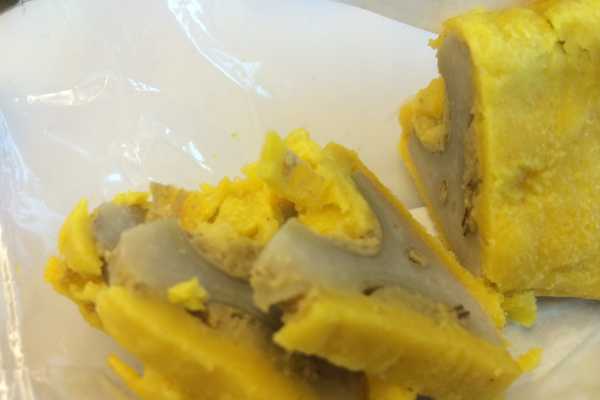
We cut slices and tried it on its own. It’s an interesting textural experience. The lotus root is crunchy, the mustard seeds are mustard seeds and hot, but not blow the roof of your mouth off hot and the batter was just a little soggy. Then we ate the rest of it cut into slices and added to an otherwise boring ham sandwich and that was cool. Like adding crisps to cheese sandwiches: it just makes it “je ne sais quoi” but really really good.
Thick White Bread and Picnics
With only 24 days in Japan we had to make the most of our time there and the budget (in both money and time terms) wasn’t going to stretch to eating three meals a day in cafes and restaurants. Often we’d eat breakfast in our room (buying bread, bananas and jam the night before from the ubiquitous 7-11). There are kettles in EVERY room in Japan. And they’re usually big kettles, so boiling eggs inside them is easy. Fillings from the same 7-11 were also easy – sliced cheese, ham, pre-boiled eggs (although we did our own). And in Japan we found the thickest white bread ever.
The loaves all seemed to be the same size – with no end crusts – but the smaller the number of slices, the thicker the slice. Heaven. And a full belly.
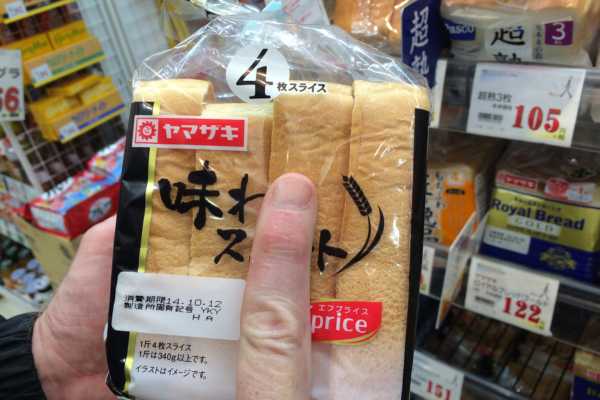
Onigiri
Similarly to South Korea, when the thought of thick white bread was too much we’d take to the local snack of onigiri – a rice triangle, often with a filling of tuna, seafood, pork or chicken (we even found Kimchee once 🙂 ) and covered in seaweed. Easy to eat, something of an acquired taste, but we’ve missed them since leaving Japan. Read more about Japanese Snacks in our in-depth article here.

Miyajima Oysters
The specialty of Miyajima Island is Oysters. Arrive on the ferry and you’ll find them virtually in every place where you can eat here, from the restaurants to the street food stalls. Fresh with a little lemon? Perhaps you’d like them grilled. You can pick them up for 200 yen each and they are usually sold two at a time. > read our guide on what to do in Miyajiima here
There’s also a small stall selling two Miyajima Oysters in a fried bun with curry. How could we resist?

Gyoza
These are the Japanese take on the small dumplings that the Chinese are so good at. Boiled, in soup or pan-fried, the cook at the Ni-No-Ni cafe in Kumamoto asked us? He’d been sent to rescue us as we’d scouted their website seen pictures and assumed there would be pictures when we got there. Nope. And he was the only English speaker. A plate of pan-fried dumplings, two beers, stir fried pork, garlic and green beans plus chili prawns later we were agreeing that his English was excellent. Gyoza are not a patch on Yangs Fry Dumplings from Shanghai, but they’re probably a more sensible number of calories!!
Read about learning to make your own Gyoza and other Japanese cooking courses here
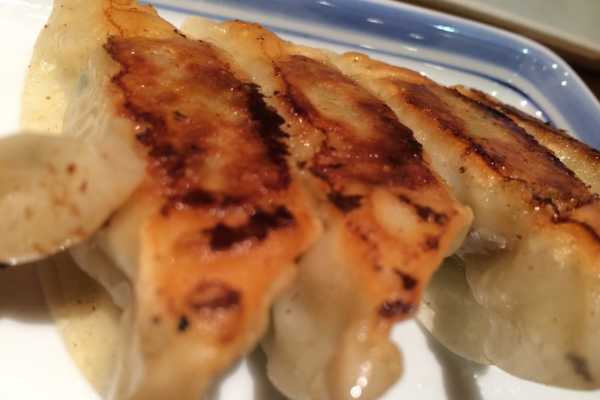
Okonomiyaki
This comfort food was something we first saw on the Hairy Bikers Asian Special and just had to try it. If there had been nothing else to see in Hiroshima we would have come for the Okonomyaki alone..
PRACTICAL TRAVEL TIPS
- 🛡️ Get Travel Insurance: Civitatis includes medical expenses, repatriation, theft, luggage delays. No deductibles or upfront payments. Get a quote here.
- 💰 Read about the Currency in Japan and ATM fees.
- 🔌 Check out Japan’s plug, socket & power situation.
- 📶 Internet, maps, and data on the go. eSims for Japan
Shochu – an acquired taste
Kagoshima is famous not just for the active volcano, Sakurajima, and for being a jumping-off point for the Unesco world heritage island of Yakoshima but also for Shochu. It’s the local firewater, the Kagoshima version of sake.
We bought the smallest bottle possible. 200 ml for 200 Yen. It might get you drunk quick but you’re unlikely to have fun getting there unless you have a strong stomach and few taste buds. It has recently made a comeback. In the 1970’s it was apparently used as an industrial cleaner. I suspect, then, that there is no constipation in my immediate future.
Sake
We couldn’t visit Japan and not try Sake. There were a few tastes – first of all our trip to Saijo, Sake Town, near Hiroshima, and then a taster when we blew the US$250 on our night in the ryokan in the spa town of Kinosaki, but although it was much better than the Shochu we generally stuck to beer when we did drink in Japan.
Japanese Beer
At usually more than US$4.50 for a beer, there was little drinking in Japan. Cans of Japanese beer were available in most hotels – in a vending machine by the laundry, for around 250 Yen (US$2.50).
But our best experience was in visiting the Asahi Brewery, where those nice folks got us slightly buzzed for free. In Sapporo it wasn’t free, but still a pleasant building to take a look around.
Cup Noodles – a Japanese Food Revelation
We’ve eaten a lot of instant noodles in the past few months. Here in Japan we even had instant noodles that had a small pizza and a slice of cheese inside (note: do not attempt this, it is neither clever or tasty, unless you like cardboard).

The instant noodle was invented here in Japan, in Ikeda – and our trip to the museum and factory (where we made our own cup noodle) has changed forever my future noodle eating.
Cheese curry instant noodles.

I’m telling you. It’s AMAZING. Actually all of the Cup Noodles that we ate put every other instant noodle in the shade. Thick chunky noodles. Lots and lots of sauce. And fillings that look like they do on the adverts.
Yes, really. Here’s a pic, but go read about making your own noodles, and then go yourself.
Japanese Curry
My mouth is watering typing this. I am in lust with Japanese curry. Seriously. My lust-affair started when we stumbled into a fast food joint called Coco Ichiban (and yes, I know you can find these in Los Angeles – I know this NOW!).
So the Japanese curry. It’s like a mix between a thin Chinese curry (that you’d get from a Chinese takeaway in the UK) with a little Indian spice. But that’s where the similarities end. Served with oodles of slightly salty, sticky Japanese rice, and a breaded pork cutlet it’s just amazing. Yup. Breaded pork cutlet. Or scrambled eggs. Or cheese. Or a burger. Well, I didn’t try the burger. But this is just amazing-tasting comfort food that I can kid myself is healthy-ish. There was a lot of Japanese curry in our 24 days in the country.

Hokkaido Curry Soup
It’s cold up north goes the saying in the UK and the same stands for the northern prefecture of Japan – Hokkaido. With that in mind, the locals tinkered with the concept of noodle soup and Japanese curry and delivered curry soup. Moorish, full of vegetables and goodness with the interesting spice of a curry. Soup curry Samurai in Sapporo provided a fix and an almost European feel to the cozy little first-floor restaurant.
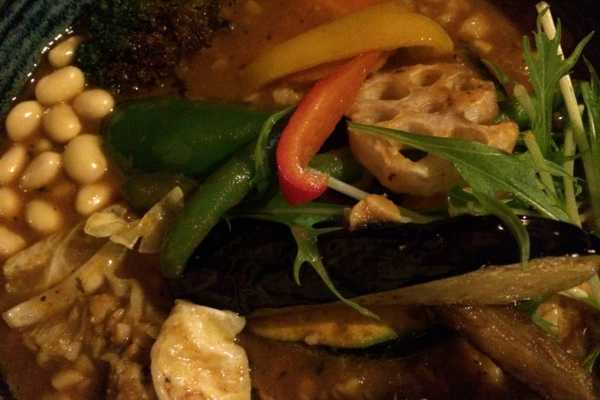
Donburi Breakfast Bowls
What I don’t understand is the fact that we’re still in the frozen north, in Hakodate, just a little bit south of Sapporo, but still in the prefecture of Hokkaido. It’s necessary to have hot curry soup to warm your insides, but here the specialty is squid and raw fish for breakfast. They even have squid logos on their sewer and drain covers.
Hakodate is the centre of the Japanese universe when it come to fresh fish. Some say even better fresh fish can be found here than at the Tsukiji fish market in Tokyo. And here, we had to try the Donburi fish bowl for breakfast.
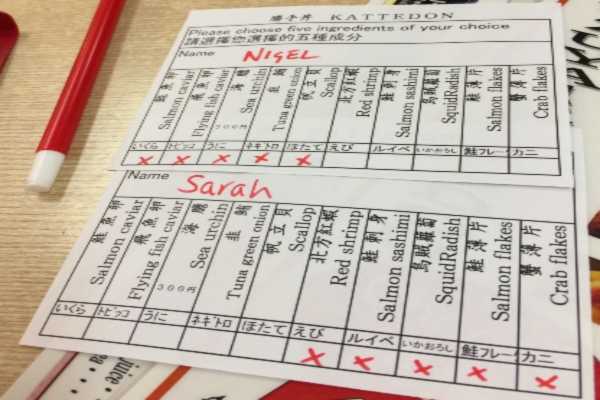
We arrived in the dark and the rain last night. At 5am, when you’re supposed to head to the nearby fish market to see all the action and to grab some breakfast it was still raining and we pulled the covers over our heads again. By 9am, when we surface, the action has slowed, but of course there’s still food available.
Donburi is a bowl of rice with various elements of sushi on top. There are the usual fixings that you get with a Japanese meal, which essentially means a few little dishes and then we dig into the main attraction.
A specialty here in Hakodate is fish eggs. So of course we select that.
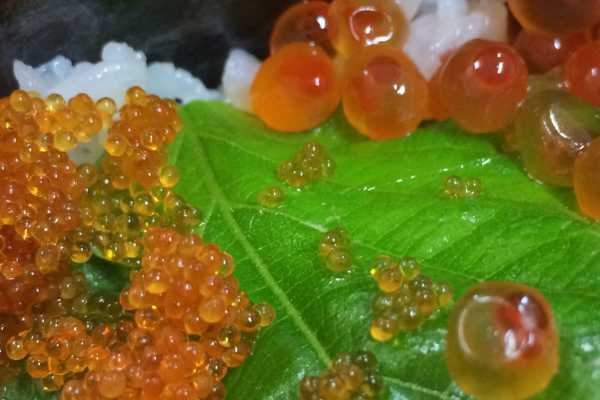
Our menu selection lets us go for everything that’s available between us. There’s what tastes like tuna mayonnaise, tuna sashimi, salmon sashimi, two different sorts of fish eggs, but no sea urchin, we’ll have to save that for another time.
Sashimi
The sashimi is cold to the point of almost frozen, but at least we figure, all the bacteria will be dead and we plow on.

The rice below the fish is warm and I’m coming to love the slightly sticky Japanese rice, which makes it easier to pick up in chopsticks.
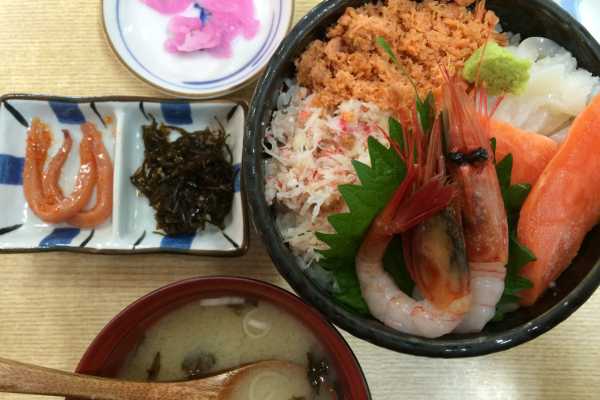
And once I get over the fact that I’m eating cold raw fish for breakfast it’s actually pretty good.
We could have actually caught our own squid right here in the marketplace. And then had it prepared for us.
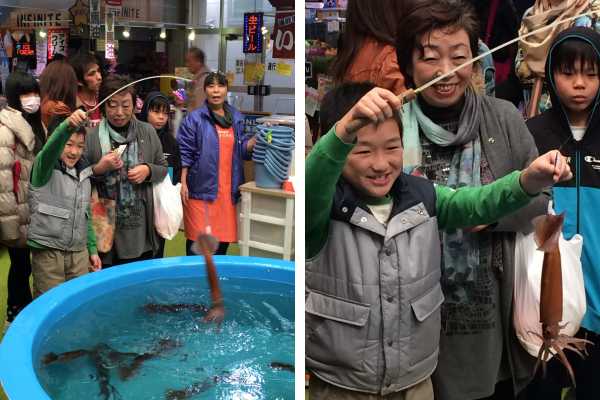
The squid is sliced immediately and delivered as sushi (i.e. raw). Some pieces are still moving as you put them in your mouth #asteptoofar
Fast Food and Department Store Food
In most towns and cities you’ll find a department store (or more!) and usually in the basement there’s a set of fast food places. Often these places will have a vending machine where you’ll buy tickets for the food you want. You’ll then hand over your tickets to the server behind the counter and sometimes have to explain what you want. That’s fab because now there are two chances to mess it up!
Places like Sukiya and Ringer Hut were great for good food at a decent price.

Sure you can get a burger, but there are also fixes of noodles, rice dishes, and sushi. It was in these types of places that we found affordable food and got to try some of the regional dishes, like….
Cold Soba Noodles
Soba is the Japanese name for buckwheat, and soba noodles are a thin noodle (unlike udon, which is a thick noodle). The famous way to eat soba noodles is cold. Yep. Cold. Not just lukewarm, but actually run under cold water cold.
We found them in Matsumoto – where there are a variety of places you can pick them up – from the train station, to expensive restaurants.

We ate them cold, served on a bamboo tray called a zaru, with a tsuyu dipping sauce (dark soy mixed with a a rice wine called mirin). Pick up the noodles, swirl them in the sauce and try not to dribble it down yourself.
Houtou Noodles
When we reached Kawaguchiko for our trip up Mount Fuji we needed warmth and it was to the hot Houtou Noodle that we turned. Udon like (i.e. thick), these noodles are placed raw into the pot with the rest of the ingredients and then boiled along with them. Although you can’t consider the Houtou Noodle udon because the dough is prepared like a dumpling dough rather than like a noodle dough.

Houtou Fudou right by the railway station in Kawaguchiko provided us with our fix, although they might have convinced us to buy more if they’d provided heating, or even closed the door! Our Houtou noodles comprised miso soup vegetables and noodles.
Tempura
Whether it’s shrimp or vegetable, tempura from Japan is on the whole, light, crispy and a whole different experience from the more westernized and heavy tempura we’ve had before.


We tried it a couple of times, and found it good, but you know, that Japanese curry, it’s just got a hold on me..
Yakitori
It’s usually known as a beer snack, and we weren’t frequenting the drinking areas during our trip, so we’d headed for a place that did a selection of Japan-wide yakitori. Chalk it down to experience.
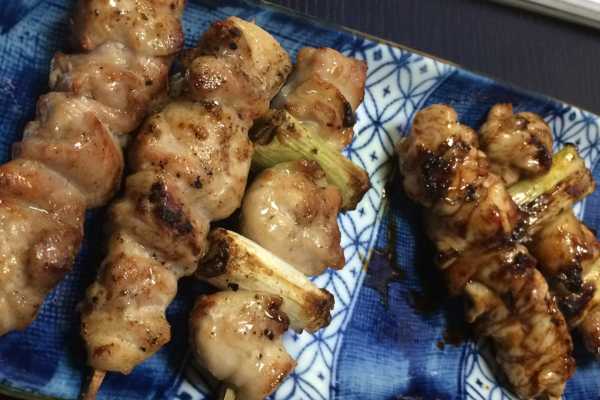
This skewered, grilled chicken snack wasn’t great and we weren’t tempted to find more, not with so much other great food to eat.
Takoyaki
This is a round ball-shaped snack that is a specialty of Osaka. And you can find them EVERYWHERE in the city.
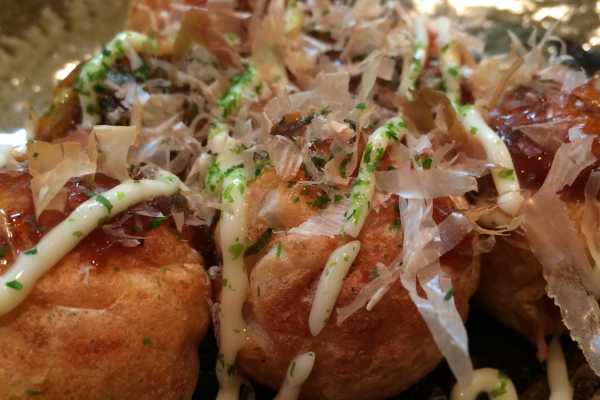
It’s made of a wheat based flour batter, filled with diced octopus, ginger and green onion. It’s then cooked in a special takoyaki pan, brushed with a sauce that is similar to a mix of Worcestershire sauce and mayonnaise and then you get sprinkles of green onion and dried bonito. It’s a very tasty snack.
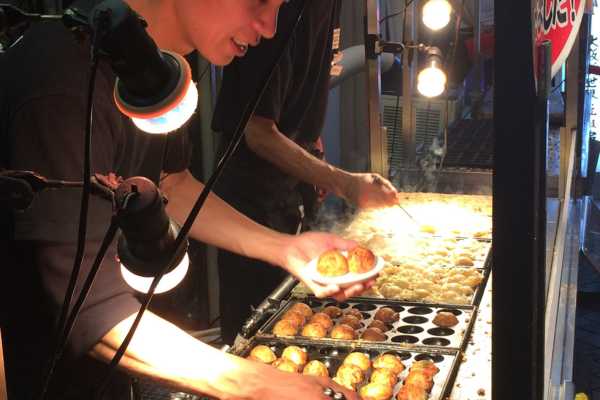
Wasabi
We can’t talk about food in Japan without talking about Wasabi. Not just because the sushi chef at Daiwa Sushi in the Tsukiji Fish Market didn’t trust us, but because it’s a whole industry here and our experience of it was free! Close to Matsumoto, the Daio Wasabi Farm is free to enter, free to wander around, and free to get to (if you have a JR Pass and are happy to spend about an hour walking through the glorious countryside to get there).
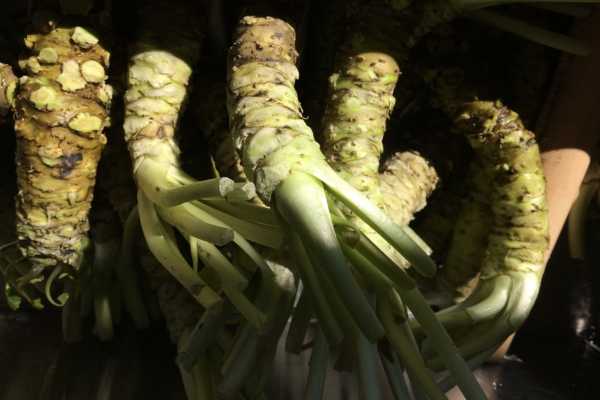
The Wasabi ice cream didn’t have much bite until we got a dollop of pure wasabi dumped on top.
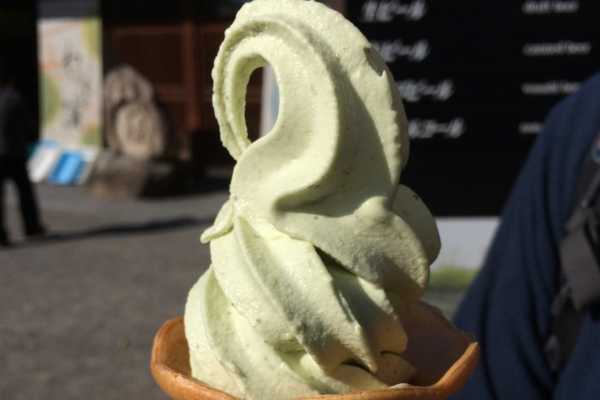
Hot and cold all in the same mouthful. Definitely worth a try.
The food in Japan has been amazing. All of it. But the final word must go to the raw fish that Japan is so famous for. Sushi.
Sushi
I’d never eaten sushi until I went skiing in Aspen in 2004. My first attempt to eat sushi comprised of one mouthful and then three large glasses of Sauvignon Blanc. Things have changed since then, although I’d never been to a Sushi Conveyor Belt restaurant – or a kaiten as they’re known here in Japan – until we got here to Japan. Now, of course, I’ve been to lots.
Sushi in Japan comes in all shapes and sizes and lots of it is very seasonal and there are regional specialities. One regional speciality that is seasonal is the firefly squid, or Hotaru-ika – you’ll find it in Toyama Prefecture and going out on a boat to see them caught is a fabulous thing to do in Japan. Here’s how to do that.
The Old Tsukiji Fish Market Sushi
The best experience for sushi, though, goes to Daiwa Sushi, where after we’d got up at 3 a.m. to watch the tuna auction, we blew US$35 for 20 minutes of sushi magic at 6:30 a.m. and tasted the most sublime eel sushi ever.
I can’t finish this blog without talking about plastic models. There’s a whole huge industry in Japan around plastic models of food.

Where restaurants display models in their windows, so you know what you’re getting. It begs the question though, as to what comes first, the model or the food. And how the menu of a restaurant is driven by available models..
It was a relief to see that they hadn’t forgotten to make plastic bacon available, although I must have missed the restaurant carrying the HP Sauce to go with it..
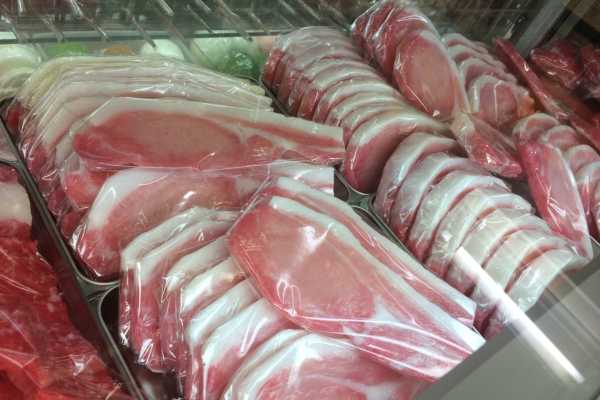
Are you traveling for Food? Read these guides.
If traveling for food is important to you, then check out some more of our guides to some of the world’s best food.
- The best food to eat in South Korea
- A Guide to Vietnamese Food
- What to eat in Laos
- Japanese Food not to miss
- The best Japanese Snacks
- The food of Yorkshire, England
- What to eat in Genoa, Italy
- The Best Bulgarian Food Guide
- A guide to Costa Rican Food
- Georgian Food to Eat
- What to eat in Myanmar – a Burmese Food Guide
- Indonesian Food to Try
- What to Eat in Penang, Malaysia
- What to eat in Sri Lanka – Sri Lankan Food Guide
- What to eat in Amritsar, India
- A Guide to the food specialties of Jaipur
JAPAN TRAVEL RESOURCES
TRAIN TICKETS
Easiest way to buy train tickets, use Klook for Shinkansen Train Tickets, check timetables & reserve seats.
Book Train Tickets
HOTELS AND APARTMENTS
See choices here
Sea view rooms? Budget rooms? Need a washing machine? The best choice of hotels & apartments.
TOURS & ATTRACTIONS
Most excursion choices, small group tours, skip-line tickets, free cancellation and top local guides.
Top options here.
CAR RENTAL GUIDE
Read my Guide
Best choice of vehicles, automatics, large or small cars, child seats. Book early for more options.
ASocialNomad is a participant in the Amazon Services LLC Associates Program, an affiliate advertising program designed to provide a means for sites to earn advertising fees by advertising and linking to amazon.com, amazon.co.uk, and amazon.ca. Amazon and the Amazon logo are trademarks of Amazon.com, Inc. or its affiliates. As an Amazon Associate, I earn from qualifying purchases.

